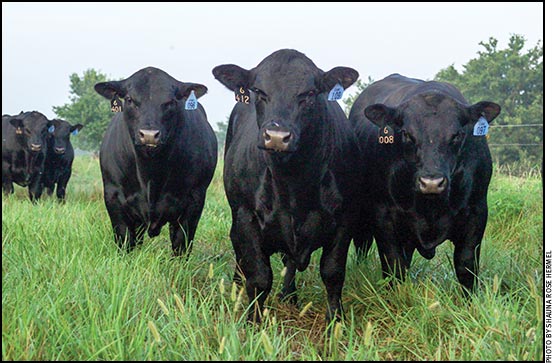
Ensuring Bull Fertility
Sire fertility is crucial to breeding program success.
 Much of a cow herd’s genetic potential lies with its herd sires, making bull fertility a vital component of an operation’s breeding program. John Kastelic, professor of animal reproduction and head of the Department of Production Animal Health at the University of Calgary Faculty of Veterinary Medicine, explained the importance of producing and selecting healthy bulls at the Applied Reproductive Strategies in Beef Cattle (ARSBC) symposium Aug. 30.
Much of a cow herd’s genetic potential lies with its herd sires, making bull fertility a vital component of an operation’s breeding program. John Kastelic, professor of animal reproduction and head of the Department of Production Animal Health at the University of Calgary Faculty of Veterinary Medicine, explained the importance of producing and selecting healthy bulls at the Applied Reproductive Strategies in Beef Cattle (ARSBC) symposium Aug. 30.
Nutrition until 25-30 weeks of age can ultimately determine the reproductive health of a bull, Kastelic said. If bulls are fed at a moderate level up to 30 weeks of age, it not only optimizes the growth of the bull, but also his reproductive potential, he said.
“On the other hand,” he continued, “if we underfeed bulls prior to 25-30 weeks, we cause a permanent decrease in the size of the testes and, to some extent, delayed puberty.”
Overfeeding bulls after 25-30 weeks of age can cause reductions in semen quality and fertility, as well as other health issues.

“It’s crucial that a bull is normal and healthy, has no structural defects, and that he meets the minimum requirements in motility, morphology and scrotal circumference to be deemed acceptable,” said John Kastelic of the University of Calgary Faculty of Veterinary Medicine.
To be reproductively sound, a bull must be able to identify cows that are in estrus, he must be able to mount and breed those cows, and he must be able to deliver large numbers of normal sperm. A decrease in one or more of those qualities will result in limited fertility.
When examining bulls, Kastelic looks at the health and well-being of the bull, his structural soundness, and evidence of infectious disease or any other abnormalities that would affect his ability to successfully breed cows.
Kastelic emphasized the importance of correctly measuring scrotal circumference and collecting and evaluating semen. Minimum requirements include a maximum of 30% abnormal sperm cells, a maximum of 20% sperm with head defects and a minimum of 30% sperm motility.
There are also minimum standards for scrotal circumference, but they vary from one breed to another, he said.
“It’s crucial that a bull is normal and healthy, has no structural defects, and that he meets the minimum requirements in motility, morphology and scrotal circumference to be deemed acceptable,” Kastelic said.
If a bull is deemed unacceptable, he is sorted into one of two categories. Bulls deemed permanently unacceptable possess a defect that is very unlikely to improve, he said. If a bull is currently unacceptable, but believed able to improve, he is sorted into the second category where a reevaluation is recommended in three to six weeks or longer.
“We really encourage people to do bull breeding soundness exams, and really the intent there is to identify the bulls that will have low fertility,” Kastelic said. “It’s difficult or impossible to identify one bull as being a better bull or having higher fertility. Really, our goal is to eliminate the bulls at the lower end that would not be expected to have reasonable fertility.”
Failure to conduct a bull breeding soundness exam can result in significant and expensive losses at the production level, he said.







